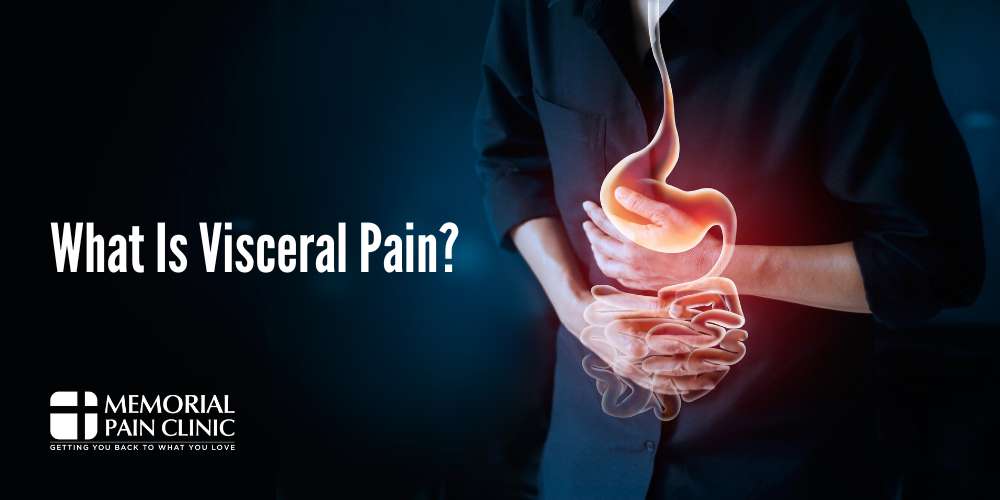Visceral pain is a type of pain that originates from the internal organs, often making it difficult to pinpoint the exact source. Unlike pain you may feel from a cut or muscle injury, visceral pain can be deep, dull, and hard to localize, sometimes spreading across larger areas of the body. It is commonly associated with conditions affecting the stomach, intestines, bladder, and other internal organs.
At Memorial Pain Clinic in Tulsa, OK, we understand how challenging visceral pain can be and are committed to providing compassionate care through comprehensive pain management strategies.
Whether you need help with the treatment of visceral pain or clinical pain management in Tulsa, our team is here to support your journey to pain relief. Call us today at (918)-200-9944 or contact us online to learn more about how we can help.
What Is Visceral Pain?
Unlike pain from a cut or injury, visceral pain tends to be vague and poorly localized, meaning patients may struggle to determine exactly where the discomfort is coming from. This type of pain is commonly linked to gastrointestinal, reproductive, or urinary organs, often manifesting as a dull, aching sensation that can radiate to other areas of the body.
Conditions like irritable bowel syndrome (IBS) or endometriosis may be common culprits for patients with visceral pain, and even certain types of cancer pain can be visceral in nature. Researchers use tools like functional magnetic resonance imaging (fMRI) to better understand visceral pain patterns, including phenomena such as visceral hyperalgesia, where patients experience an increased sensitivity to pain from internal organs.
These insights are crucial in helping medical professionals create more effective treatment plans for visceral pain patients.
What Are the Visceral Organs?
The visceral organs are the soft internal organs housed within the body’s main cavities, primarily responsible for maintaining essential functions like digestion, respiration, and reproduction. These organs include components of the gastrointestinal tract, such as the stomach, intestines, liver, and other key systems like the heart, lungs, and reproductive organs.
Visceral organs are different from the muscles and bones of the body, which are protected by subcutaneous tissue, the layer of fat and skin that cushions the body’s surface. Pain originating from these visceral organs, like gastrointestinal or gynecological pain, is transmitted through pathways that connect to the spinal cord, contributing to the diffuse and often hard-to-locate nature of visceral pain.
Visceral vs Somatic Pain
Somatic and visceral pain are two distinct types of pain that arise from different parts of the body. Somatic pain comes from the skin, muscles, bones, and other soft tissues and is typically felt as sharp and localized discomfort. It is the kind of acute pain you might experience from an injury, such as a cut, bruise, or bone fracture, and is usually easy to pinpoint.
On the other hand, visceral pain often presents as a deep, aching sensation that is harder to locate precisely. Unlike somatic pain, visceral pain tends to be diffuse, sometimes radiating to other areas of the body, making it more challenging to identify its source. Both somatic and visceral pain require different treatment approaches, as understanding where the pain is coming from helps guide effective pain management strategies.
What Does Visceral Pain Feel Like?

Visceral pain can be challenging to describe because it often doesn’t feel like the sharp, localized pain we typically associate with injuries. Instead, it is commonly experienced as a deep, dull, or aching discomfort that can be hard to pinpoint.
The pain perception for visceral pain can vary widely with some people feeling a constant, nagging ache, while others experience sharp, wave-like sensations. A key feature of visceral pain is referred pain, where the discomfort is felt in areas of the body other than the source, making diagnosis more complicated.
For instance, pain from the gallbladder can be felt in the shoulder or back. Chronic visceral pain, which persists over a longer period, often leads to fluctuating pain intensity, making it unpredictable and difficult to manage. This variability is what makes visceral pain unique and often more challenging to treat effectively.
Where Is Visceral Pain Felt?
Visceral pain is typically felt deep within the body, originating from internal organs such as those in the abdomen or chest. Unlike pain from the skin or muscles, visceral pain can be difficult to pinpoint because of the way sensory innervation works in the body. The internal organs have a less specific sensory innervation compared to surface tissues, meaning the brain has a harder time determining the exact location of the pain.
This often results in referred pain, where the discomfort is experienced in areas far from the actual source. For instance, pain from a heart attack may be felt in the arm or jaw rather than directly in the chest. This complex interaction between sensory signals makes visceral pain challenging to locate and diagnose accurately, which is why understanding referred pain is crucial for effective treatment.
What Symptoms Are Associated with Visceral Pain?

Visceral pain often comes with a variety of symptoms beyond the sensation of pain, due to the significant involvement of the nervous system. In addition to discomfort, which can be felt as chest pain or deep abdominal pain, individuals often experience changes in body temperature and blood pressure, as visceral pain triggers motor and autonomic reflexes throughout the body. This type of pain is often accompanied by other symptoms, such as nausea, sweating, and even psychological symptoms like anxiety or a feeling of impending doom.
These reactions occur because the internal organs are closely linked to the autonomic nervous system, which controls many involuntary body functions. Visceral pain related to conditions such as heart issues or gastrointestinal distress can therefore provoke significant autonomic responses, adding to the complexity of diagnosing and managing this type of pain.
What Are Some Examples of Visceral Pain?
Visceral pain syndromes include a variety of conditions characterized by pain originating from the internal organs. Common examples include functional gastrointestinal disorders such as irritable bowel syndrome (IBS) and non-cardiac chest pain, which are often linked to visceral hypersensitivity, which is an increased sensitivity to pain in the internal organs. Visceral pain can also arise from conditions like endometriosis or cancer pain, where tumors impact internal structures.
Abdominal Pain
Abdominal pain often arises from visceral structures within the digestive system, such as the stomach, intestines, or liver. Pain originating from these visceral structures can be dull, aching, and difficult to localize, making it challenging to identify the exact cause. Common conditions like appendicitis, gallbladder disease, or gastritis can all lead to abdominal discomfort, highlighting the complexity of pain involving the internal organs.
Pelvic Pain
Chronic pelvic pain often involves discomfort originating from the pelvic organs, such as the uterus, bladder, or intestines. Chronic pelvic pain can result from various conditions including endometriosis and interstitial cystitis. The persistence of this pain makes it particularly challenging, as it may have multiple contributing factors, often requiring a multidisciplinary approach for effective management.
What Causes Visceral Pain?
Visceral pain is caused by issues affecting visceral organs, such as those in the digestive, reproductive, or urinary systems. True visceral pain is typically poorly localized, which makes it difficult for patients to pinpoint the exact source of their discomfort. The process begins with visceral nociception, where pain receptors in these internal organs respond to harmful stimuli, such as noxious colorectal distension or inflammation. This pain signal travels to the brain stem, where it is processed, often leading to sensations that can spread or radiate.
The temporal evolution of visceral pain, including its persistence, can lead to central sensitization, a phenomenon where the nervous system becomes more sensitive to stimuli over time. Pain research highlights the importance of understanding the underlying mechanisms of visceral pain to guide a differential diagnosis. Many potential causes can contribute to the pain, requiring careful assessment for effective treatment.
Can Body Changes Cause Visceral Pain?
Yes, certain changes in the body can indeed cause visceral pain, particularly by affecting visceral sensitivity. Factors such as inflammation, hormonal shifts, or nerve dysfunction can heighten visceral sensitivity, making internal organs more reactive to stimuli. These heightened responses amplify pain signals, even to normally non-painful stimuli, leading to discomfort or chronic visceral pain. These processes can contribute to the development of chronic visceral pain, which may be persistent and require specialized management strategies to alleviate.
Can Certain Conditions Cause Visceral Pain?
Certain medical conditions can directly lead to visceral pain, often through disturbances in how the body processes visceral input. Conditions like irritable bowel syndrome (IBS), endometriosis, and pancreatitis all involve abnormalities in the internal organs that trigger pain related to these structures.
This pain results from visceral input being interpreted as harmful by the nervous system, leading to discomfort that can be deep, aching, and difficult to locate. For example, inflammation, obstruction, or changes in blood flow to the visceral organs can activate pain pathways and cause ongoing pain, making effective diagnosis and treatment essential.
How Is Visceral Pain Treated and Managed?

Treating visceral pain can be complex, as it often involves addressing both the symptoms and the underlying causes. The treatment approach may vary depending on the source of the pain, whether it’s related to gastrointestinal issues, endometriosis, or other internal organ dysfunctions.
In some cases, visceral pain is associated with cancer pain, requiring specialized cancer pain management techniques to provide comfort and improve quality of life.
For individuals suffering from chronic visceral pain, a combination of medications, lifestyle changes, and interventions like nerve blocks may be used to help reduce the frequency and intensity of the pain. Effective management typically involves a multi-disciplinary approach, ensuring all aspects of the patient’s condition are addressed to achieve the best possible outcomes.
Pain Medications
One of the primary methods of pain management for visceral pain is the use of medications, which can help reduce pain intensity and improve quality of life. Healthcare providers may prescribe a variety of pain medications, such as anti-inflammatories, antispasmodics, or even opioids for severe cases. Depending on the nature of the pain, antidepressants or anticonvulsants might also be used to target nerve-related pain pathways.
Since visceral pain can be challenging to treat, healthcare providers should closely monitor the patient’s response to medication and make adjustments as needed. Sometimes, combining medication with other non-drug treatments can enhance the overall effectiveness of pain management, helping patients regain control of their daily activities.
Physical Therapy
Physical therapy is another valuable component in managing visceral pain, particularly for those experiencing chronic symptoms. Physical therapists can help patients with exercises that target core stability and muscle relaxation, reducing tension in the abdomen and pelvis that can aggravate pain.
In addition to traditional physical therapy techniques, transcutaneous electrical nerve stimulation (TENS) may also be used to provide pain relief. This involves applying a mild electrical current to targeted areas, which helps interrupt pain signals and reduce the perception of discomfort.
By combining movement-based therapies with methods like TENS, physical therapy aims to support better movement and function while reducing the overall burden of visceral pain.
Contact Memorial Pain Clinic for Visceral Pain Treatment in Tulsa, Ok

If you’re struggling with visceral pain and are seeking effective pain control, the Memorial Pain Clinic in Tulsa, OK, is here to help. Our team understands how debilitating visceral pain can be and offers personalized pain management solutions to meet your needs.
Whether you are dealing with chronic pain or a new health concern, we are dedicated to providing comprehensive care that helps you regain comfort and control over your life.
Contact Memorial Pain Clinic today at (918)-200-9944 to learn more about our visceral pain treatment options and how we can support you on your path to relief.

